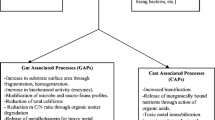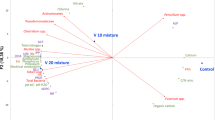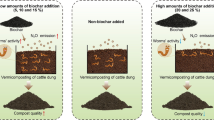Abstract
Vermicompost is a substantial source of nutrients, promotes soil fertility, and maintains or increases soil organic matter levels. Potentially toxic elements (PTEs) in vermicompost impact on nitrification activity. However, it is yet unknown how vermicompost affects nitrifying bacteria and archaea, comammox Nitrospira inopinata (complete ammonia oxidizers), net nitrification rates (NNRs), and PTEs. The effects of vermicompost application on NNRs, potential nitrification rates (NPs), PTEs, and the abundances of comammox N. inopinata bacteria, nitrite-oxidizing bacteria (NOB), and ammonia-oxidizing bacteria (AOB)/archaea (AOA) were studied. NNRs and NPs were significantly higher (p < 0.05) in fresh cow-dung vermicompost (stored for 40 days) as compared with other organic manure. The level of PTEs (Cu2+, Fe2+, Pb2+, Cd2+, and Zn2+) was significantly lower (p < 0.05) in vermicompost as compared with compost of waste material with Trichoderma and cow dung. Comammox N. inopinata, NOB, AOB, and AOA were significantly higher (p < 0.05) in stored cow-dung vermicompost (more than 1 year) as compared with other organic manure. The results of the scatterplot matrix analysis suggested that Fe2+, total nitrogen (TN), soil organic carbon (SOC), and total carbon (TC) were linearly correlated (p < 0.001) with NNRs and NPs in vermicompost and organic manure. Similarly, comammox N. inopinata bacteria, NOB, AOB, and AOA were linearly correlated (p < 0.001) with NNR and NP. These results indicated that vermicompost promoted nitrification activity by increasing microbial diversity and abundance, supplying nutrients and organic matter for microbial growth, and facilitating complex microbial interactions. It may be concluded that the influence of vermicompost, which played a great role in PTE concentration reduction, increased chemical, and biological properties, increased the growth rate of nitrifying bacteria/archaea and the nitrogen cycle.






Similar content being viewed by others
Data availability
The corresponding author will decide whether data and materials are available.
References
Ahmad, A., Aslam, Z., Bellitürk, K., Ullah, E., Raza, A., & Asif, M. (2022). Vermicomposting by bio-recycling of animal and plant waste: A review on the miracle of nature. Journal of Innovative Sciences, 8(2), 175–187. https://doi.org/10.17582/journal.jis/2022/8.2.175.187
Akhila, A., & Entoori, K. (2022). Role of earthworms in soil fertility and its impact on agriculture: A review. International journal of fauna and biological studies, 9(3), 55–63. https://doi.org/10.22271/23940522.2022.v9.i3a.907
Akter, R., Mukhles, M. B., Rahman, M. M., Rana, M. R., Huda, N., Ferdous, J., Rahman, F., Rafi, M. H., & Biswas, S. K. (2022). Effect of pesticides on nitrification activity and its interaction with chemical fertilizer and manure in long-term paddy soils. Chemosphere, 304, 135379. https://doi.org/10.1016/j.chemosphere.2022.135379
Ali, N., Khan, S., Khan, M. A., Waqas, M., & Yao, H. (2019). Endocrine disrupting pesticides in soil and their health risk through ingestion of vegetables grown in Pakistan. Environmental Science and Pollution Research, 26(9), 8808–8820. https://doi.org/10.1007/s11356-019-04287-y
Ali, M., Khanom, A., Nahar, K., Ali, M. Y., Azad, M., Kalam, A., & Rahman, M. M. (2021). Effect of manure application on net nitrification rates, heavy metal concentrations and nitrifying archaea/bacteria in soils. Bulletin of Environmental Contamination and Toxicology, 106(4), 707–713. https://doi.org/10.1007/s11356-019-04287-y
Bannert, A., Mueller-Niggemann, C., Kleineidam, K., Wissing, L., Cao, Z. H., Schwark, L., & Schloter, M. (2011). Comparison of lipid biomarker and gene abundance characterizing the archaeal ammonia-oxidizing community in flooded soils. Biology and Fertility of Soils, 47(7), 839–843. https://doi.org/10.1007/s00374-011-0552-6
Briffa, J., Sinagra, E., & Blundell, R. (2020). Heavy metal pollution in the environment and their toxicological effects on humans. Heliyon, 6(9), 04691. https://doi.org/10.1016/j.heliyon.2020.e04691
Chen, X. P., Zhu, Y. G., **a, Y., Shen, J. P., & He, J. Z. (2008). Ammonia-oxidizing archaea: Important players in paddy rhizosphere soil? Environmental Microbiology, 10(8), 1978–1987. https://doi.org/10.1111/j.1462-2920.2008.01613.x
Daims, H., Lebedeva, E. V., Pjevac, P., Han, P., Herbold, C., Albertsen, M., Jehmlich, N., Palatinszky, M., Vierheilig, J., Bulaev, A., & Kirkegaard, R. H. (2015). Complete nitrification by Nitrospira bacteria. Nature, 528(7583), 504–509. https://doi.org/10.1038/nature16461
Das, D., Abbhishek, K., Banik, P., & Swain, D. K. (2022). Comparative evaluation of changes in soil bio-chemical properties after application of traditional and enriched vermicompost. Environmental Technology & Innovation, 28, 102956. https://doi.org/10.1016/j.eti.2022.102956
Dollhopf, S. L., Hyun, J. H., Smith, A. C., Adams, H. J., O’Brien, S., & Kostka, J. E. (2005). Quantification of ammonia-oxidizing bacteria and factors controlling nitrification in salt marsh sediments. Applied and Environmental Microbiology, 71(1), 240–246. https://doi.org/10.1128/AEM.71.1.240-246.2005
Edori, O. S., Edori, E. S. (2012). Effect of auto mechanic works on lead and iron content in two mechanic villages in Port Harcourt, Rivers State Nigeria. Journal of Applied Sciences and Environmental Management, 16(4), 317–321.
Fu, K., Zhang, X., Fan, Y., Bian, Y., Qiu, F., Cao, X. (2023). The enrichment characterization of Nitrospira under high DO conditions. Environmental Technology, 1–22. https://doi.org/10.1080/09593330.2023.2165457
Gómez-Brandón, M., Aira, M., Lores, M., & Domínguez, J. (2011). Changes in microbial community structure and function during vermicomposting of pig slurry. Bioresource Technology, 102(5), 4171–4178. https://doi.org/10.1016/j.biortech.2010.12.057
Han, S., Delgado-Baquerizo, M., Luo, X., Liu, Y., Van Nostrand, J. D., Chen, W., Zhou, J., & Huang, Q. (2021). Soil aggregate size-dependent relationships between microbial functional diversity and multifunctionality. Soil Biology and Biochemistry, 154, 108143. https://doi.org/10.1016/j.soilbio.2021.108143
Herrmann, M., Saunders, A. M., & Schramm, A. (2009). Effect of lake trophic status and rooted macrophytes on community composition and abundance of ammonia-oxidizing prokaryotes in freshwater sediments. Applied and Environmental Microbiology, 75(10), 3127–3136. https://doi.org/10.1128/AEM.02806-08
Huang, Z., & He, W. (2023). Impacts of biochar and vermicompost addition on physicochemical characteristics, metal availability, and microbial communities in soil contaminated with potentially toxic elements. Sustainability, 15, 790. https://doi.org/10.3390/su15010790
Khanom, A., Azad, M. A. K., Ali, M. M., Ali, M. Y., Biswas, S. K., & Rahman, M. M. (2021). Plants and microbes’ responses to the net nitrification rates of chemical fertilizers in vegetable soils. Applied Soil Ecology, 158, 103783. https://doi.org/10.1016/j.apsoil.2020.103783
Kits, K. D., Sedlacek, C. J., Lebedeva, E. V., Han, P., Bulaev, A., Pjevac, P., Daebeler, A., Romano, S., Albertsen, M., Stein, L. Y., & Daims, H. (2017). Kinetic analysis of a complete nitrifier reveals an oligotrophic lifestyle. Nature, 549(7671), 269–272. https://doi.org/10.1038/nature23679
Kumar, S., Sharma, V., Bhoyar, R. V., Bhattacharyya, J. K., & Chakrabarti, T. (2008). Effect of heavy metals on earthworm activities during vermicomposting of municipal solid waste. Water Environment Research, 80(2), 154–161. https://doi.org/10.1002/j.1554-7531.2008.tb00339.x
Li, C., Hu, H. W., Chen, Q. L., Chen, D., & He, J. Z. (2019). Comammox Nitrospira play an active role in nitrification of agricultural soils amended with nitrogen fertilizers. Soil Biology and Biochemistry, 138, 107609. https://doi.org/10.1016/j.soilbio.2019.107609
Li, C., He, Z. Y., Hu, H. W., & He, J. Z. (2023). Niche specialization of comammox Nitrospira in terrestrial ecosystems: Oligotrophic or copiotrophic? Critical Reviews in Environmental Science and Technology, 53(2), 161–176. https://doi.org/10.1080/10643389.2022.2049578
Lores, M., Gómez-Brandón, M., Pérez-Díaz, D., & Domínguez, J. (2006). Using FAME profiles for the characterization of animal wastes and vermicomposts. Soil Biology and Biochemistry, 38(9), 2993–2996. https://doi.org/10.1016/j.soilbio.2006.05.001
Maji, D., Misra, P., Singh, S., & Kalra, A. (2017). Humic acid rich vermicompost promotes plant growth by improving microbial community structure of soil as well as root nodulation and mycorrhizal colonization in the roots of Pisum sativum. Applied Soil Ecology, 110, 97–108. https://doi.org/10.1016/j.apsoil.2016.10.008
Mupambwa, H. A., Haulofu, M., Nciizah, A. D., & Mnkeni, P. N. (2022). Vermicomposting technology: A sustainable option for waste beneficiation. Handbook of Waste Biorefinery (pp. 583–600). Cham: Springer. https://doi.org/10.1007/978-3-031-06562-0_21
Nahar, K., Ali, M. M., Khanom, A., Alam, M. K., Azad, M. A. K., & Rahman, M. M. (2020). Levels of heavy metal concentrations and their effect on net nitrification rates and nitrifying archaea/bacteria in paddy soils of Bangladesh. Applied Soil Ecology, 156, 103697. https://doi.org/10.1016/j.apsoil.2020.103697
Novara, A., Catania, V., Tolone, M., Gristina, L., Laudicina, V. A., & Quatrini, P. (2020). Cover crop impact on soil organic carbon, nitrogen dynamics and microbial diversity in a Mediterranean semiarid vineyard. Sustainability, 12(8), 3256. https://doi.org/10.3390/su12083256
Pang, Y., & Wang, J. (2021). Inhibition of ferrous iron (Fe2+) to sulfur-driven autotrophic denitrification: Insight into microbial community and functional genes. Bioresource Technology, 342, 125960.
Pathma, J., & Sakthivel, N. (2013). Molecular and functional characterization of bacteria isolated from straw and goat manure based vermicompost. Applied Soil Ecology, 70, 33–47. https://doi.org/10.1016/j.apsoil.2013.03.011
Rahman, M. M., Basaglia, M., Vendramin, E., Boz, B., Fontana, F., Gumiero, B., & Casella, S. (2014). Bacterial diversity of a wooded riparian strip soil specifically designed for enhancing the denitrification process. Biology and Fertility of Soils., 50, 25–35. https://doi.org/10.1007/s00374-013-0828-0
Rahman, M. M., Shan, J., Yang, P., Shang, X., **a, Y., & Yan, X. (2018). Effects of long-term pig manure application on antibiotics, abundance of antibiotic resistance genes (ARGs), anammox and denitrification rates in paddy soils. Environmental Pollution, 240, 368–377. https://doi.org/10.1016/j.envpol.2018.04.135
Rahman, M. M., Khanom, A., & Biswas, S. K. (2021). Effect of pesticides and chemical fertilizers on the nitrogen cycle and functional microbial communities in paddy soils: Bangladesh perspective. Bulletin of Environmental Contamination and Toxicology, 106(2), 243–249. https://doi.org/10.1007/s00128-020-03092-5
Raimi, A. R., Atanda, A. C., Ezeokoli, O. T., Jooste, P. J., Madoroba, E., & Adeleke, R. A. (2022). Diversity and predicted functional roles of cultivable bacteria in vermicompost: Bioprospecting for potential inoculum. Archives of Microbiology, 204(5), 1–13. https://doi.org/10.1007/s00203-022-02864-3
Ramos, R. F., Santana, N. A., de Andrade, N., Romagna, I. S., Tirloni, B., de Oliveira Silveira, A., Domínguez, J., & Jacques, R. J. S. (2022). Vermicomposting of cow manure: Effect of time on earthworm biomass and chemical, physical, and biological properties of vermicompost. Bioresource Technology, 345, 126572. https://doi.org/10.1016/j.biortech.2021.126572
Raza, S. T., Zhu, Y., Wu, J., Rene, E. R., Ali, Z., Feyissa, A., Khan, S., Anjum, R., Bazai, N. A., & Chen, Z. (2022). Different ratios of Canna indica and maize–vermicompost as biofertilizers to improve soil fertility and plant growth: A case study from southwest China. Environmental Research, 215, 114374. https://doi.org/10.1016/j.envres.2022.114374
Roy, S., Sarkar, D., Datta, R., Bhattacharya, S. S., & Bhattacharyya, P. (2022). Assessing the arsenic-saturated biochar recycling potential of vermitechnology: Insights on nutrient recovery, metal benignity, and microbial activity. Chemosphere, 286, 131660. https://doi.org/10.1016/j.chemosphere.2021.131660
Sheng, R., Meng, D., Wu, M., Di, H., Qin, H., & Wei, W. (2013). Effect of agricultural land use change on community composition of bacteria and ammonia oxidizers. Journal of Soils and Sediments, 13(7), 1246–1256. https://doi.org/10.1007/s11368-013-0713-3
Sinha, R. K., Agarwal, S., Chauhan, K., & Valani, D. (2010). The wonders of earthworms & its vermicompost in farm production: Charles Darwin’s ‘friends of farmers’, with potential to replace destructive chemical fertilizers. Agricultural Sciences, 1(02), 76. https://doi.org/10.4236/as.2010.12011
Sintia, M., Rahman, M. M., Khanom, A., Huq, M., Ali, M., Rauf, M., Banu, N. A., Biswas, S. K., Azad, M., & Kalam, A. (2021). Differential response of the nitrifying microbes and net nitrification rates (NNRs) between different cereal and legume crop soils with chemical fertilization. Arabian Journal of Geosciences, 14(18), 1–11. https://doi.org/10.1007/s12517-021-08250-5
Song, X., Liu, M., Wu, D., Qi, L., Ye, C., Jiao, J., & Hu, F. (2014). Heavy metal and nutrient changes during vermicomposting animal manure spiked with mushroom residues. Waste Management, 34(11), 1977–1983. https://doi.org/10.1016/j.wasman.2014.07.013
Swati, A., & Hait, S. (2017). Fate and bioavailability of heavy metals during vermicomposting of various organic wastes—A review. Process Safety and Environmental Protection, 109, 30–45. https://doi.org/10.1016/j.psep.2017.03.031
Tang, Y., Yu, G., Zhang, X., Wang, Q., Tian, D., Tian, J., Niu, S., & Ge, J. (2019). Environmental variables better explain changes in potential nitrification and denitrification activities than microbial properties in fertilized forest soils. Science of the Total Environment, 647, 653–662. https://doi.org/10.1016/j.scitotenv.2018.07.437
Traoré, S., Guébré, D., Hien, E., Traoré, M., Lee, N., Lorenz, N., & Dick, R. P. (2022). Nutrient cycling and microbial responses to termite and earthworm activity in soils amended with woody residues in the Sudano-Sahel. European Journal of Soil Biology, 109, 103381. https://doi.org/10.1016/j.ejsobi.2021.103381
Van Kessel, M. A., Speth, D. R., Albertsen, M., Nielsen, P. H., Op den Camp, H. J., Kartal, B., Jetten, M. S., & Lücker, S. (2015). Complete nitrification by a single microorganism. Nature, 528(7583), 555–559. https://doi.org/10.1038/nature16459
Vuković, A., Velki, M., Ečimović, S., Vuković, R., Štolfa Čamagajevac, I., & Lončarić, Z. (2021). Vermicomposting—Facts, benefits and knowledge gaps. Agronomy, 11(10), 1952. https://doi.org/10.3390/agronomy11101952
**, H., Zhou, X., Arslan, M., Luo, Z., Wei, J., Wu, Z., & El-Din, M. G. (2022). Heterotrophic nitrification and aerobic denitrification process: Promising but a long way to go in the wastewater treatment. Science of the Total Environment, 805, 150212. https://doi.org/10.1016/j.scitotenv.2021.150212
Xun, W., **ong, W., Huang, T., Ran, W., Li, D., Shen, Q., Li, Q., & Zhang, R. (2016). Swine manure and quicklime have different impacts on chemical properties and composition of bacterial communities of an acidic soil. Applied Soil Ecology, 100, 38–44. https://doi.org/10.1016/j.apsoil.2015.12.003
Yao, H., Gao, Y., Nicol, G. W., Campbell, C. D., Prosser, J. I., Zhang, L., Han, W., & Singh, B. K. (2011). Links between ammonia oxidizer community structure, abundance, and nitrification potential in acidic soils. Applied and Environmental Microbiology, 77(13), 4618–4625. https://doi.org/10.1128/AEM.00136-11
Zhang, T., Ye, L., Tong, A. H. Y., Shao, M. F., & Lok, S. (2011). Ammonia-oxidizing archaea and ammonia-oxidizing bacteria in six full-scale wastewater treatment bioreactors. Applied Microbiology and Biotechnology, 91(4), 1215–1225. https://doi.org/10.1007/s00253-011-3408-y
Funding
The University Grant Commission (UGC), Bangladesh, provided some partial funds (Fund no: 141/Edu/IU-2023/694).
Author information
Authors and Affiliations
Contributions
N.H. (Nazmul Huda), M.R.R. (Md. Rasel Rana), and M.M.R. (M. Mizanur Rahman) conceptualized and planned the study, carried out the analysis, and wrote the manuscript. M.R.R. and M.M.R. created the graphs and illustrations. M.A.H. (Md. Amdadul Huq), A.A. (Abdullah Al-Mamun), S.T.R. (Shabiha Tasbir Rahman), and M.K.A. (Md. Khasrul Alam) contributed to the critical revision and wrote the manuscript. M.M.R. oversaw the entire project, and all authors gave their approval to the final manuscript.
Corresponding author
Ethics declarations
Ethical approval
No studies by any of the authors of this article involved using human or animal subjects.
Consent to participate
Before beginning to write the article, each co-author gave their full approval and agreement.
Consent for publication
Before beginning the submission procedure, each co-author is given the opportunity to provide their approval for the publishing of this manuscript.
Competing interests
The authors declare no competing interests.
Additional information
Publisher's Note
Springer Nature remains neutral with regard to jurisdictional claims in published maps and institutional affiliations.
Supplementary Information
Below is the link to the electronic supplementary material.
Rights and permissions
Springer Nature or its licensor (e.g. a society or other partner) holds exclusive rights to this article under a publishing agreement with the author(s) or other rightsholder(s); author self-archiving of the accepted manuscript version of this article is solely governed by the terms of such publishing agreement and applicable law.
About this article
Cite this article
Huda, N., Rana, M.R., Huq, M.A. et al. Understanding vermicompost and organic manure interactions: impact on toxic elements, nitrification activity, comammox Nitrospira inopinata, and archaea/bacteria. Environ Monit Assess 196, 355 (2024). https://doi.org/10.1007/s10661-024-12491-8
Received:
Accepted:
Published:
DOI: https://doi.org/10.1007/s10661-024-12491-8




